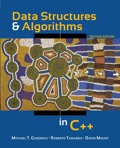
Data structures and algorithms in C++
2nd Edition
ISBN: 9780470460443
Author: Goodrich
Publisher: WILEY
expand_more
expand_more
format_list_bulleted
Question
Chapter 1, Problem 1R
Program Plan Intro
The variables:
- The variable is a named location in a memory. In this location the
program can manipulate the data. - This location holds the value of the variable.
- The value of the variable gets changed in the program.
- The C++ variable can be any type like “int”, “float”, “char” and so on.
Expert Solution & Answer
Explanation of Solution
Rules for naming the C++ variable:
- The name of the variable must begin with a letter or underscore.
- The name of the variables is case sensitive.
- The name of the variable can be constructed with digits and letters.
- Special symbols other than underscore are not allowed in the variable name.
- Valid variable names are, “i_think_i_am_valid”, “i_may_have_2_many_digits_2_be_valid”, “_I_start_and_end_with_underscores_”, “I_AM_LONG_AND_HAVE_NO_LOWER_CASE LETTERS”
- Example for invalid variable name is “I_Have_A_Dollar_$ign”. This is invalid because the name contains the special character “$”.
From the given set of variable names, the invalid variable name is “I_Have_A_Dollar_$ign”. Hence the correct option is “d”.
Want to see more full solutions like this?
Subscribe now to access step-by-step solutions to millions of textbook problems written by subject matter experts!
schedule05:09
Students have asked these similar questions
Dijkstra's Algorithm (part 1). Consider the network shown below, and Dijkstra’s link-state algorithm. Here, we are interested in computing the least cost path from node E (note: the start node here is E) to all other nodes using Dijkstra's algorithm. Using the algorithm statement used in the textbook and its visual representation, complete the "Step 0" row in the table below showing the link state algorithm’s execution by matching the table entries (i), (ii), (iii), and (iv) with their values. Write down your final [correct] answer, as you‘ll need it for the next question.
4. |z + 5 - 5i| = 7
14.
dz,
C: |z❘
C: |z❘ = 0.6
ze² - 2iz
H
Chapter 1 Solutions
Data structures and algorithms in C++
Ch. 1 - Prob. 1RCh. 1 - Prob. 2RCh. 1 - Give a C++ definition of a struct called Pair that...Ch. 1 - Prob. 4RCh. 1 - Prob. 5RCh. 1 - Prob. 6RCh. 1 - Prob. 7RCh. 1 - Write a short C++ function, isMultiple, that takes...Ch. 1 - Write a C++ function printArray(A, m, n) that...Ch. 1 - What (if anything) is different about the behavior...
Ch. 1 - Write a C++ class, Flower, that has three member...Ch. 1 - Modify the CreditCard class from Code Fragment 1.3...Ch. 1 - Modify the CreditCard class from Code Fragment 1.2...Ch. 1 - Modify the CreditCard class from Code Fragment 1.2...Ch. 1 - Modify the CreditCard class from Code Fragment 1.2...Ch. 1 - Prob. 16RCh. 1 - Write a short C++ function, isMultiple, that takes...Ch. 1 - Write a short C++ function, isTwoPower, that takes...Ch. 1 - Write a short C++ function that takes an integer n...Ch. 1 - Write a short C++ function that takes an integer n...Ch. 1 - Write a short C++ function that takes a positive...Ch. 1 - Write a pseudo-code description of a method that...Ch. 1 - Prob. 2CCh. 1 - Prob. 3CCh. 1 - Prob. 4CCh. 1 - Prob. 5CCh. 1 - Write a short C++ program that outputs all...Ch. 1 - Write a short C++ program that takes all the lines...Ch. 1 - Prob. 8CCh. 1 - Prob. 9CCh. 1 - Write an efficient C++ function that takes any...Ch. 1 - The greatest common divisor, or GCD, of two...Ch. 1 - A common punishment for school children is to...Ch. 1 - Write a C++ program that, when given a starting...
Knowledge Booster
Similar questions
arrow_back_ios
SEE MORE QUESTIONS
arrow_forward_ios
Recommended textbooks for you
 Database System ConceptsComputer ScienceISBN:9780078022159Author:Abraham Silberschatz Professor, Henry F. Korth, S. SudarshanPublisher:McGraw-Hill Education
Database System ConceptsComputer ScienceISBN:9780078022159Author:Abraham Silberschatz Professor, Henry F. Korth, S. SudarshanPublisher:McGraw-Hill Education Starting Out with Python (4th Edition)Computer ScienceISBN:9780134444321Author:Tony GaddisPublisher:PEARSON
Starting Out with Python (4th Edition)Computer ScienceISBN:9780134444321Author:Tony GaddisPublisher:PEARSON Digital Fundamentals (11th Edition)Computer ScienceISBN:9780132737968Author:Thomas L. FloydPublisher:PEARSON
Digital Fundamentals (11th Edition)Computer ScienceISBN:9780132737968Author:Thomas L. FloydPublisher:PEARSON C How to Program (8th Edition)Computer ScienceISBN:9780133976892Author:Paul J. Deitel, Harvey DeitelPublisher:PEARSON
C How to Program (8th Edition)Computer ScienceISBN:9780133976892Author:Paul J. Deitel, Harvey DeitelPublisher:PEARSON Database Systems: Design, Implementation, & Manag...Computer ScienceISBN:9781337627900Author:Carlos Coronel, Steven MorrisPublisher:Cengage Learning
Database Systems: Design, Implementation, & Manag...Computer ScienceISBN:9781337627900Author:Carlos Coronel, Steven MorrisPublisher:Cengage Learning Programmable Logic ControllersComputer ScienceISBN:9780073373843Author:Frank D. PetruzellaPublisher:McGraw-Hill Education
Programmable Logic ControllersComputer ScienceISBN:9780073373843Author:Frank D. PetruzellaPublisher:McGraw-Hill Education

Database System Concepts
Computer Science
ISBN:9780078022159
Author:Abraham Silberschatz Professor, Henry F. Korth, S. Sudarshan
Publisher:McGraw-Hill Education

Starting Out with Python (4th Edition)
Computer Science
ISBN:9780134444321
Author:Tony Gaddis
Publisher:PEARSON

Digital Fundamentals (11th Edition)
Computer Science
ISBN:9780132737968
Author:Thomas L. Floyd
Publisher:PEARSON

C How to Program (8th Edition)
Computer Science
ISBN:9780133976892
Author:Paul J. Deitel, Harvey Deitel
Publisher:PEARSON

Database Systems: Design, Implementation, & Manag...
Computer Science
ISBN:9781337627900
Author:Carlos Coronel, Steven Morris
Publisher:Cengage Learning

Programmable Logic Controllers
Computer Science
ISBN:9780073373843
Author:Frank D. Petruzella
Publisher:McGraw-Hill Education